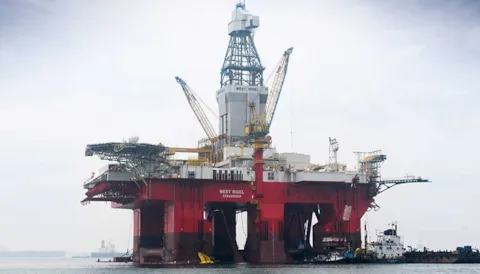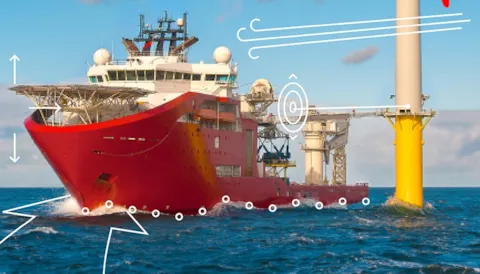DNV is the global leader in WTIV assurance and a trusted partner for from design to deployment.
DNV is the leading classification partner in the wind turbine installation vessels (WTIV) market, actively involved in the majority of the world’s offshore wind projects. This deep involvement gives us unmatched expertise in navigating the complexities and logistical challenges unique to the sector.
We offer a full-scope approach that covers vessel structure, system integration, mission-critical equipment, and statutory compliance for wind installation vessel projects. From early design to long-term operation, we support owners, yards, and developers in minimizing risks, and delivering safe, efficient, and future-ready WTIVs. Through digital tools and advisory services for environmental and emissions management, we also support the offshore wind industry achieve smarter operations and sustainable performance.
DNV’s classification rules and standards for WTIVs are among the most advanced in the industry, helping our partners to exceed performance targets, while meeting safety and regulatory requirements.
Navigating the demands of a future-ready WTIV
Increasingly complex structures and regulations
The rapid expansion of offshore wind is driving WTIV designs to new limits, with the deployment of increasingly larger turbines and support structures. These offshore wind turbine installation vessels have complex and demanding load profiles and are required to perform challenging crane lifting operations using a variety of mission specific equipment.
WTIVs are also subject to a growing array of global regulatory frameworks, including the IMO’s Industrial Personnel (IP) Code, International Labour Organization (ILO) standards, EU Monitoring, Reporting and Verification (MRV) Regulations for greenhouse gas (GHG) emissions; and flag-specific safety standards, making regulatory alignment and operational readiness more critical than ever.
With deep expertise in the complexities of WTIVs and offshore wind farm operations, DNV is a trusted technical partner throughout the vessel’s lifecycle. From design and construction to active operations, we collaborate closely with our clients to overcome challenges and deliver reliable technical support. Backed by a global network of surveyors and specialists, we provide responsive, on-site assistance wherever and whenever it’s needed.
Pressure to optimize operations
Wind turbine installation vessels are under increasing pressure to reduce lifecycle costs, improve performance, and adapt to new fuel systems and energy efficiency standards.
DNV focuses on incorporating operational efficiency into design considerations as well as maximizing existing fleet potential.
We support the integration of digital tools, tailored classification regimes, and smart asset management strategies, enabling lower operating expenses, extended survey intervals, and readiness for alternative fuels.
DNV has actively supported the development of alternative fuel-ready WTIVs, such as:
- Cadeler’s P-class vessels, designed for future fuel flexibility, including methanol and various biofuels
- Seaway7’s battery-hybrid units, prepared for integration with hydrogen fuel cells.
Our offshore strategic priorities in Decarbonization, Digitalization, Asset Integrity, and Cost Savings aligns with the industry's demands to ensure safe and efficient operation of all WTIVs worldwide.
Our unique approach to WTIV projects
|
DNV provides full-scope classification for all vessel segments, covering vessel structures, safety and lifesaving systems, cranes, and dynamic positioning systems. |
|
Drawing on its extensive experience, DNV identifies and addresses key technical risks for WTIVs, and verifies critical vessel aspects, such as main dimensions and layout, overturning stability, and the design of the jacking system and leg-hull interface. DNV’s Noble Denton suite provides a collection of services from Marine Warranty and Geotechnical Engineering to Dynamic Positioning Assurance and Oceanographic Studies. |
|
Using DNV’s SESAM and Nauticus software, DNV supports hull fatigue analysis and structural reassessment for lifetime extensions. |
|
DNV certifies essential marine and industrial systems critical to WTIV functionality, including cranes, jacking systems, power and automation, and other complex industrial interfaces. |
|
Mission equipment must operate reliably in demanding offshore conditions to ensure safe and efficient wind turbine installation. DNV provides certification and verification of critical systems, including handling cranes, grippers, and skidding mechanisms, to guarantee robust design, seamless integration, and dependable operation of all mission equipment. We apply a risk-based methodology to assess the mission-critical systems, verifying redundancy, fail-safe features, and emergency procedures.
|
|
DNV conducts independent assessments and surveys at fabrication locations to ensure systems, structures, and safety functions meet class and regulatory requirements before deployment. |
|
Drawing on decades of experience from the global fleet of offshore units in DNV class, a lifecycle approach is used for newbuilding projects to allow different asset management strategies for the in-operation phase. This ranges from traditional calendar-based follow-up to more modern data-driven digital solutions such as condition monitoring and risk-based inspection regimes. Our digital tools on the Veracity platform allow for remote data driven verification, resulting in safer and more cost-efficient operations through application of a targeted inspection approach. This increases owner flexibility, while reducing intrusive inspections and class-induced costs. |
| Why partner with DNV? |
|---|
|
| We support various types of offshore wind assets: |
|
Customers and cases





